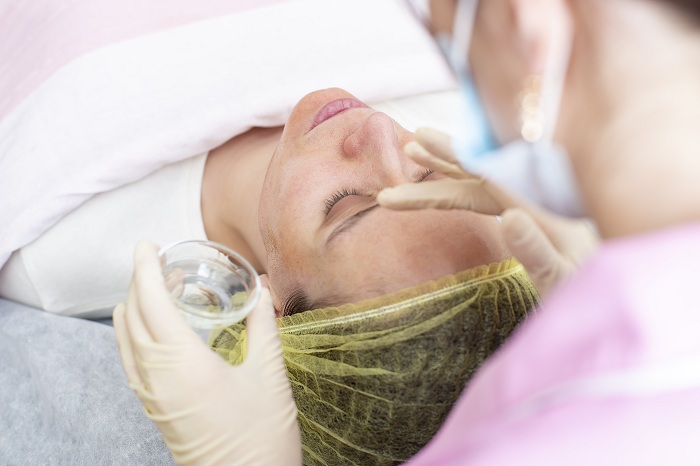Skin discoloration is very common and caused by a variety of different things. From pigmented birthmarks and sun exposure to infections and a skin rash.
When your skin tone is changing color, your first thought is probably: how can I prevent it from getting any worse?
In this article, we’ll be discussing how discoloration can occur and what you can do about it.
Contents
- What Causes Skin Color To Turn Black?
- What Makes Your Skin Dark and What Are the Different Types of Discoloration?
- Common Forms of Pigmentation – What Causes Skin Color Changes?
- What Are the Treatments for Skin Pigmentation Disorders?
- How to Get Rid of Pigmentation on Arms, Stomach, Back, or Face
- How Long Does It Take for Discoloration to Heal?
- FAQs:
- Conclusion
What Causes Skin Color To Turn Black?
Our skin color can change a lot over our lifetime, and changes in our skin won’t always mean that we have a skin pigmentation disorder.
Certain medications and health conditions can cause areas of your skin to turn into a darker brown hue, and scar tissue or blood vessels bursting can also affect the tone of your skin.
Dark skin patches can be quite noticeable as they’re different from your normal skin pigment.
What Makes Your Skin Dark and What Are the Different Types of Discoloration?

Melanin is a pigment that gives our skin its color. The more melanin you have, the darker your skin will be and the less melanin you have, the lighter your skin.[1]
Skin pigmentation disorders can affect large or small areas of the skin. They can be a natural part of the aging process, but could also be early signs of an underlying health condition that you should get checked out.
Common Forms of Pigmentation – What Causes Skin Color Changes?
Not all skin discolorations are the same, here are some of the most common types:
- Sun Spots
- Vitiligo
- Psoriasis
- Hyperpigmentation
- Birthmarks
- Injury or trauma
- Melasma
Here are some of the most common, and how they are caused:
Sun Spots – Light Brown Patches from Too Much Melanin

Sun spots are a type of discoloration that is caused by prolonged sun exposure. They normally appear as dark, flat patches of skin that show up over time.
They don’t need to be treated, but many people choose to get them removed. They are also similar in appearance to melasma which can be triggered by things like medication or pregnancy.
Vitiligo – White Spots
This is a chronic skin condition that appears as pale white patches that show up around various areas of the skin. It starts when melanin cells die or stop functioning properly.
Psoriasis – Itchy Red Skin
This is a type of autoimmune disease where the body starts attacking healthy skin cells. Psoriasis can appear as red, scaly patches on the skin that feel dry and itchy.
Hyperpigmentation – Skin Turning Dark Brown
This is a usually harmless condition where the skin gets slightly darker. It’s caused when there’s an excess of melanin forming in the skin.
What Are the Treatments for Skin Pigmentation Disorders?
There are three main ways that you can treat discolorations, all of which have slightly different effects.
You may have to go to a professional in order to get some discoloration treatments, but there are also products that you can buy at the pharmacy.
How to Get Rid of Pigmentation on Arms, Stomach, Back, or Face
Here are the three most common treatments:
Laser Treatment to Help with Skin Disorder
This is an intense treatment that is highly effective at lightening skin areas. It can be expensive and you may need to go back for multiple treatments to see a big difference.
Topical Creams for Symptoms of Hyperpigmentation
You can buy serums and moisturizers that contain ingredients like retinol, vitamin C, or tranexamic acid which have all been shown to decrease the appearance of dark spots.
Chemical Peels for Too Much Melanin

Finally, you can get chemical treatments that contain ingredients like salicylic acid and glycolic acid that gently exfoliate the skin to remove the discolored layer.
If you are only experiencing slight discoloration, it’s best to start with topical creams first. If you have very dark spots, you might want to consider laser therapy.
How Long Does It Take for Discoloration to Heal?
It is possible for discoloration to heal without you having to take any action. If you have a patch of skin that’s slightly darker on your neck, back, arms or nose, it should fade to your normal skin color within 6 to 12 months.
However, if the color is deep within your skin it can sometimes take years to fade away.
You can speed up the process by using one of the treatments mentioned above, but even with these, you might not see any changes until after a couple of months.
FAQs:
Here are some frequently asked questions regarding skin pigmentation and discoloration:
Q: What to use for preventing skin conditions like hyperpigmentation?
Unfortunately, many types of skin discoloration cannot be prevented as they occur naturally, or come as a result of other health conditions.
You can prevent hyperpigmentation by avoiding exposure to the sun where possible. You can do this by wearing a hat or reducing the amount of skin you have on the show, or by wearing SPF every day.
Q: How to get rid of skin discoloration?

There’s no easy way that you can fix skin discoloration.
There is a range of treatments that may fade the appearance of dark spots over time but it is a long process.
You can also use products to get rid of skin dryness to calm your skin rash.
Q: When should I worry about skin discoloration symptoms?
Most of the time you shouldn’t worry about skin discoloration, but there are cases where pigmentation can turn into skin cancer, a skin infection, or basal cell carcinoma.
If you start noticing changes in your skin’s appearance, and texture, or it becomes painful, it’s best to seek medical help, but don’t worry about it being skin cancer straight away.
Q: Does skin discoloration go away?
Some forms can fade away naturally over time and can be helped along by various treatments.
Other conditions like birthmarks, port wine stains, albinism, or vitiligo will not go away.
Q: Is discoloration of skin permanent?
It all depends on your condition. Some forms of discoloration are permanent, and some may only last a couple of weeks/months.
Q: Why do I have darker skin on some areas of my body?
It’s normal for certain parts of your body to be darker than others, especially if your discoloration is caused by exposure to the sun.
Darker areas of the skin occur when you have more melanin, so sometimes some parts can have naturally more melanin than others.
Q: Why is my face getting darker without the sun?
There are many reasons why your face is getting darker without the sun. It could be acne scars, aging spots, or hormonal imbalances.
Conclusion
In this article, we’ve gone through what causes skin color to darken over time, what are the symptoms of different skin conditions, and what helps with treating discoloration.
It’s natural for skin to change color over time so pigmentation shouldn’t be a concern straight away. If it starts getting uncomfortable or changing in appearance, it may be time to visit a medical professional.
References
[1] https://www.webmd.com/a-to-z-guides/what-is-melanin